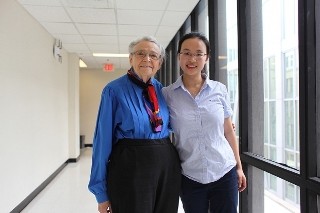Sep 22 2015
Researchers from Massachusetts Institute of Technology (MIT), along with scientists from China and Japan have developed a method to produce thin electronic materials in sizes which are larger than tiny flakes.
 Millie Dresselhaus (left) and Lin Zhou. Photo: Jose-Luis Olivares/MIT
Millie Dresselhaus (left) and Lin Zhou. Photo: Jose-Luis Olivares/MIT
Two-dimensional materials such as graphene are considered to be promising for various high-tech applications, including optical and electronic applications. Until now, it has only been possible to produce these materials in the size of tiny flakes. In this study, the research team has found out a method to produce large sheets of molybdenum telluride (MoTe2), and this method could possibly used to produce other similar 2D materials.
"This material has a similar bandgap to silicon" — which is a characteristic required for making solar cells and transistors — "and in single-layer form, it has a direct bandgap, which allows better light emission" says MIT postdoc Lin Zhou. "It also has strong absorption for solar radiation,” which is important for making practical solar cells," she says.
Molybdenum telluride has the ability to exist in natural semiconductor form or in metallic form. When it is in its semiconductor form, it would be useful for electronic applications, and when it is in its metallic form, it would be a good conductor and useful for electrical applications. The method of making this material decides whether it should be a metallic material or a semiconductor.
The method developed by the team is based upon chemical vapor deposition (CVD) process, which allows creation of sheets of desired thickness and size. The CVD chamber’s dimensions limit the size of the sheets that can be produced.
Molybdenum telluride’s atoms are bound very weakly to each other, and hence, precursor materials do not demonstrate the tendency to form molybdenum telluride material. "This makes it more challenging to make, compared to other similar materials," Zhou says.
In order to overcome this problem, the team began with a pure molybdenum layer over which they used multiple deposition stages. "This method makes it easy, because you only need to control one material," Zhou says.
The layer is then oxidized, following which it is removed. Powdered tellurium is now added, and at 700°C, it is vaporized in hydrogen and argon carrier gas. Hydrogen plays an important role in production of a uniform MoTe2 film. The team has demonstrated that the material is readily usable for production of field-effect transistors and other such electronic devices.
"Our process can grow sheets that have a very large area, are very homogeneous, and have high quality," Zhou says.
The research team now plans to adapt this process for other thin materials. “2-D materials are a big family with different properties,” Zhou says. The researchers will be attempting to find out if different versions of the method could be used.
Zhou states that molybdenum telluride is considered to hold promise for spintronics applications, where the spins of electrons and not the charge are more important.
Physicist Ado Jorio of the Federal University of Minas Gerais, Brazil, who was not part of this research, says, "What is most impressive is that this group has been able to consecutively develop new formulae to produce almost any low-dimensional material they want, always scalable with the highest quality worldwide."
And Vincent Meunier, a physicist at Rensselaer Polytechnic Institute, who was also not involved in this study, adds, "One of the many advantages of the proposed approach stems from its simplicity. The consequences of this development are likely to be numerous, as it provides a versatile and scalable technique to develop macroscopic amounts of atomically thin films, thereby surmounting major roadblocks faced by layered-materials based research so far."
The research team has published its findings in the Journal of the American Chemical Society. The team included professors Mildred Dresselhaus, Tomás Palacios and Jing Kong, and eight others from MIT; the Tohoku University and Saitama University in Japan; the National Tsing-hua University in Taiwan and the Central South University and China University of Petroleum in China.